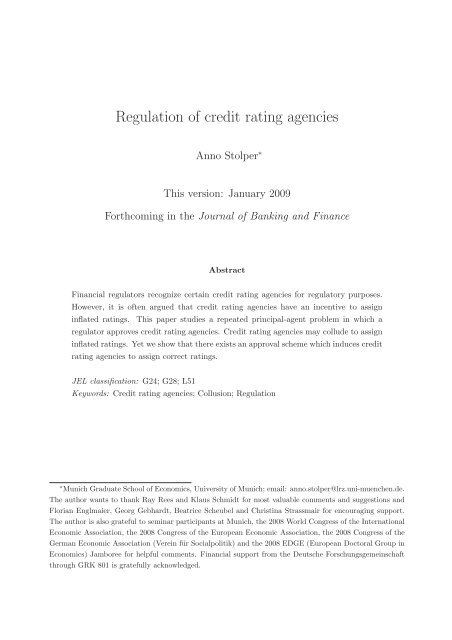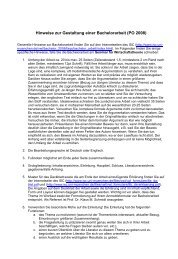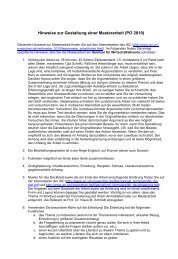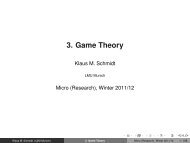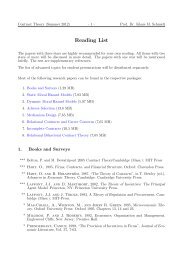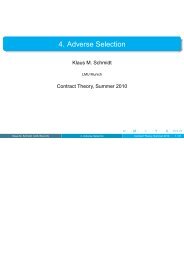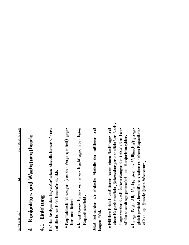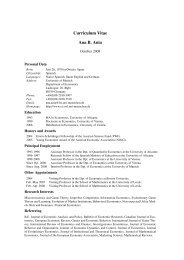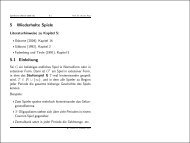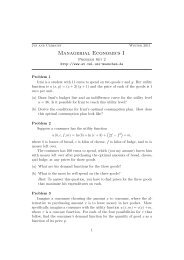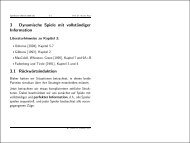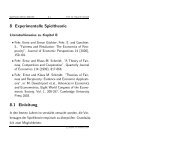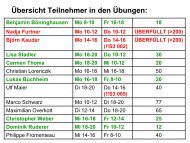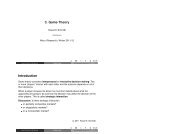Regulation of credit rating agencies - Economic Theory (Prof. Schmidt)
Regulation of credit rating agencies - Economic Theory (Prof. Schmidt)
Regulation of credit rating agencies - Economic Theory (Prof. Schmidt)
You also want an ePaper? Increase the reach of your titles
YUMPU automatically turns print PDFs into web optimized ePapers that Google loves.
<strong>Regulation</strong> <strong>of</strong> <strong>credit</strong> <strong>rating</strong> <strong>agencies</strong><br />
Anno Stolper ∗<br />
This version: January 2009<br />
Forthcoming in the Journal <strong>of</strong> Banking and Finance<br />
Abstract<br />
Financial regulators recognize certain <strong>credit</strong> <strong>rating</strong> <strong>agencies</strong> for regulatory purposes.<br />
However, it is <strong>of</strong>ten argued that <strong>credit</strong> <strong>rating</strong> <strong>agencies</strong> have an incentive to assign<br />
inflated <strong>rating</strong>s. This paper studies a repeated principal-agent problem in which a<br />
regulator approves <strong>credit</strong> <strong>rating</strong> <strong>agencies</strong>. Credit <strong>rating</strong> <strong>agencies</strong> may collude to assign<br />
inflated <strong>rating</strong>s. Yet we show that there exists an approval scheme which induces <strong>credit</strong><br />
<strong>rating</strong> <strong>agencies</strong> to assign correct <strong>rating</strong>s.<br />
JEL classification: G24; G28; L51<br />
Keywords: Credit <strong>rating</strong> <strong>agencies</strong>; Collusion; <strong>Regulation</strong><br />
∗ Munich Graduate School <strong>of</strong> <strong>Economic</strong>s, University <strong>of</strong> Munich; email: anno.stolper@lrz.uni-muenchen.de.<br />
The author wants to thank Ray Rees and Klaus <strong>Schmidt</strong> for most valuable comments and suggestions and<br />
Florian Englmaier, Georg Gebhardt, Beatrice Scheubel and Christina Strassmair for encouraging support.<br />
The author is also grateful to seminar participants at Munich, the 2008 World Congress <strong>of</strong> the International<br />
<strong>Economic</strong> Association, the 2008 Congress <strong>of</strong> the European <strong>Economic</strong> Association, the 2008 Congress <strong>of</strong> the<br />
German <strong>Economic</strong> Association (Verein für Socialpolitik) and the 2008 EDGE (European Doctoral Group in<br />
<strong>Economic</strong>s) Jamboree for helpful comments. Financial support from the Deutsche Forschungsgemeinschaft<br />
through GRK 801 is gratefully acknowledged.
1 Introduction<br />
Financial regulators recognize certain <strong>credit</strong> <strong>rating</strong> <strong>agencies</strong> for regulatory purposes. The<br />
Securities and Exchange Commission (SEC), for instance, designates Nationally Recognized<br />
Statistical Rating Organizations (NRSROs) and uses the <strong>rating</strong>s <strong>of</strong> NRSROs to evaluate the<br />
amount <strong>of</strong> capital which financial institutions are required to hold. 1 In addition, many pen-<br />
sion funds and other investors restrict their bond investments to bonds rated by a NRSRO.<br />
However, it is <strong>of</strong>ten argued that <strong>credit</strong> <strong>rating</strong> <strong>agencies</strong> have an incentive to assign in-<br />
flated <strong>rating</strong>s. Credit <strong>rating</strong> <strong>agencies</strong> assess the probability that issuers will default on their<br />
bonds. However, the major <strong>credit</strong> <strong>rating</strong> <strong>agencies</strong> are not paid by investors, but by issuers<br />
who are interested in high <strong>rating</strong>s. In addition, claiming that their <strong>rating</strong>s are independent<br />
expressions <strong>of</strong> opinion, <strong>credit</strong> <strong>rating</strong> <strong>agencies</strong> are immune to legal challenge. Lately, default<br />
rates <strong>of</strong> structured products, such as mortgage-backed securities and collateralized-debt obli-<br />
gations, have been much higher than their initial <strong>rating</strong> would suggest. As a result, <strong>credit</strong><br />
<strong>rating</strong> <strong>agencies</strong> have been accused <strong>of</strong> assigning inflated <strong>rating</strong>s to structured products.<br />
This paper studies a repeated principal-agent problem in which a regulator approves<br />
<strong>credit</strong><strong>rating</strong><strong>agencies</strong>. While<strong>credit</strong><strong>rating</strong><strong>agencies</strong>canobserveanissuer’stype, theregulator<br />
cannot. Credit <strong>rating</strong> <strong>agencies</strong> <strong>of</strong>fer each issuer a <strong>rating</strong> and are paid by the issuers who<br />
demand a <strong>rating</strong>. The regulator cannot observe whether a <strong>credit</strong> <strong>rating</strong> agency assigns<br />
correct <strong>rating</strong>s. The regulator can only observe the default rate within a <strong>rating</strong> category for<br />
each <strong>credit</strong> <strong>rating</strong> agency. The default rate within a <strong>rating</strong> category does not only depend<br />
on whether a <strong>credit</strong> <strong>rating</strong> agency assigns correct <strong>rating</strong>s. The default rate can also be<br />
influenced by a common shock. Credit <strong>rating</strong> <strong>agencies</strong> may collude to <strong>of</strong>fer inflated <strong>rating</strong>s.<br />
Yet we show that there exists an approval scheme which induces <strong>credit</strong> <strong>rating</strong> <strong>agencies</strong> to<br />
<strong>of</strong>fer correct <strong>rating</strong>s.<br />
Themodelshowsthatif<strong>credit</strong><strong>rating</strong><strong>agencies</strong>donotcolludeto<strong>of</strong>ferinflated<strong>rating</strong>s, the<br />
regulator can filter out the common shock by evaluating the relative performance <strong>of</strong> <strong>credit</strong><br />
<strong>rating</strong> <strong>agencies</strong>. If the <strong>credit</strong> <strong>rating</strong> <strong>agencies</strong>’ discount factor is sufficiently high, the threat<br />
to deny approval in future periods can deter <strong>credit</strong> <strong>rating</strong> <strong>agencies</strong> from <strong>of</strong>fering inflated<br />
<strong>rating</strong>s.<br />
However, if all approved <strong>credit</strong> <strong>rating</strong> <strong>agencies</strong> collude to <strong>of</strong>fer inflated <strong>rating</strong>s, the<br />
regulator cannot detect whether high default rates are due to collusion or the common<br />
shock. As a result, <strong>credit</strong> <strong>rating</strong> <strong>agencies</strong> may collude to <strong>of</strong>fer inflated <strong>rating</strong>s.<br />
1 See e.g. SEC (2003, 2007).<br />
1
The model shows that the regulator can prevent a collusive agreement to <strong>of</strong>fer inflated<br />
<strong>rating</strong>s by providing an incentive to deviate. The model suggests that the regulator may<br />
reward a <strong>credit</strong> <strong>rating</strong> agency which deviates from such a collusive agreement by reducing<br />
the number <strong>of</strong> approved <strong>credit</strong> <strong>rating</strong> <strong>agencies</strong> in future periods.<br />
The paper is related to the literature on relative performance evaluation first analyzed<br />
by Holmström (1982) and to the literature on collusion <strong>of</strong> certification intermediaries (e.g.<br />
Strausz, 2005; Peyrache and Quesada, 2007). Strausz (2005) and Peyrache and Quesada<br />
(2007) study incentives <strong>of</strong> a certification intermediary to collude with a seller <strong>of</strong> a product.<br />
Strausz (2005) derives conditions under which reputation enables certification intermediaries<br />
to resist capture and shows for instance that honest certification requires high prices and<br />
constitutes a natural monopoly. In contrast, Peyrache and Quesada (2007) focus on an<br />
equilibrium in which collusion may occur. They show that impatient intermediaries set lower<br />
prices in order to attract sellers with whom stakes for collusion are large. In contrast to our<br />
paper, Strausz (2005) and Peyrache and Quesada (2007) do not consider collusion between<br />
certification intermediaries. Strausz (2005) and Peyrache and Quesada (2007) moreover<br />
assume that buyers detect any collusion ex post. In our model, the regulator cannot observe<br />
whether a <strong>credit</strong> <strong>rating</strong> agency assigns correct <strong>rating</strong>s. The regulator can only observe the<br />
default rate within a <strong>rating</strong> category, which may be influenced by a common shock.<br />
There is a growing theoretical literature on <strong>credit</strong> <strong>rating</strong> <strong>agencies</strong>. For example, Mähl-<br />
mann (2008) studies implications <strong>of</strong> <strong>rating</strong> publication rights and finds that there exists an<br />
equilibrium with partial nondisclosure <strong>of</strong> low <strong>rating</strong>s. Skreta and Veldkamp (2008) study<br />
<strong>rating</strong> shopping. They show that when issuers can choose from several <strong>rating</strong>s which <strong>rating</strong><br />
to disclose, product complexity can lead to <strong>rating</strong> inflation, even if <strong>credit</strong> <strong>rating</strong> <strong>agencies</strong><br />
produce unbiased <strong>rating</strong>s. In contrast to our paper, Mählmann (2008) and Skreta and<br />
Veldkamp (2008) do not focus on <strong>credit</strong> <strong>rating</strong> <strong>agencies</strong>’ conflict <strong>of</strong> interest. Bolton et al.<br />
(2008)andMathisetal.(2008)studythisconflict. Boltonetal.(2008)findthat<strong>credit</strong><strong>rating</strong><br />
<strong>agencies</strong>mayassigninflated<strong>rating</strong>swhentherearemanynaiveinvestorsorwhen(exogenous)<br />
reputation costs are low. Mathis et al. (2008) model reputation costs endogenously. They<br />
find that a <strong>credit</strong> <strong>rating</strong> agency may assign inflated <strong>rating</strong>s when a large fraction <strong>of</strong> the<br />
<strong>credit</strong> <strong>rating</strong> agency’s income stems from <strong>rating</strong> complex products. In contrast to our paper,<br />
Bolton et al. (2008) and Mathis et al. (2008) do not consider collusion between <strong>credit</strong> <strong>rating</strong><br />
<strong>agencies</strong>.<br />
The rest <strong>of</strong> the paper is organized as follows. Section 2 presents the model. Section 3<br />
shows that there exists an approval scheme which induces all <strong>credit</strong> <strong>rating</strong> <strong>agencies</strong> to <strong>of</strong>fer<br />
correct <strong>rating</strong>s. Section 4 concludes. Pro<strong>of</strong>s are provided in the appendix.<br />
2
2 The model<br />
Consider a model with a regulator, several <strong>credit</strong> <strong>rating</strong> <strong>agencies</strong> (CRAs), and many issuers.<br />
While CRAs can observe an issuer’s type, the regulator cannot.<br />
In period 0, the regulator chooses an approval scheme. The approval w t i ∈ {0,1} <strong>of</strong><br />
CRA i in period t, t = 1,2,..., can be made contingent on the default rates which the<br />
regulator has observed previously. If the regulator approves CRA i in period t, w t i = 1. If<br />
the regulator does not approve CRA i in period t, w t i = 0. Let n t denote the number <strong>of</strong><br />
approved CRAs in period t (n t = <br />
i wt i).<br />
Each period t, t = 1,2,..., consists <strong>of</strong> 3 stages. At stage 1, the regulator decides on the<br />
approval <strong>of</strong> CRAs according to the approval scheme. At stage 2, each CRA chooses a fee<br />
and <strong>of</strong>fers a <strong>rating</strong> to each issuer. At stage 3, issuers decide whether and from which CRA<br />
to demand a <strong>rating</strong>. Figure 1 illustrates the time structure in period t, t = 1,2,....<br />
stage 1<br />
regulator<br />
approves CRAs<br />
stage 2<br />
CRAs<br />
choose fees<br />
& <strong>of</strong>fer <strong>rating</strong>s<br />
stage 3<br />
issuers<br />
demand <strong>rating</strong>s<br />
Figure 1: Time structure in period t, t = 1,2,...<br />
At the beginning <strong>of</strong> period t, t = 1,2,..., a continuum <strong>of</strong> issuers enters. To simplify<br />
notation, its mass is normalized to 1. There are two types <strong>of</strong> issuers, A and B. If no shock<br />
occurs, type-A issuers have a low default probability dA and type-B issuers have a high<br />
default probability dB, where 0 < dA < dB < 1. Let m denote the mass <strong>of</strong> type-A issuers,<br />
where 0 < m < 1. In each period, issuers are uniformly located along the unit interval<br />
according to their type. Figure 2 illustrates this. While CRAs can observe an issuer’s type<br />
and an issuer’s location on the unit interval, the regulator cannot.<br />
At stage 1, the regulator decides on the approval w t i ∈ {0,1} <strong>of</strong> CRA i according to the<br />
approval scheme. Approving a CRA for the first time generates approval costs cA. Approval<br />
costs cA may be interpreted as costs to establish a CRA. Let z t i ∈ {0,1} denote whether the<br />
regulator approves CRA i for the first time in period t.<br />
<br />
z t i =<br />
1 if w t i = 1 and w t−1<br />
i<br />
0 otherwise.<br />
3<br />
= 0<br />
(1)
density<br />
✻<br />
1<br />
0<br />
<br />
m<br />
<br />
<br />
1<br />
<br />
type A type B<br />
✲<br />
issuers<br />
Figure 2: Issuers are located along the unit interval according to their type.<br />
At stage 2, each CRA chooses a fee and <strong>of</strong>fers a <strong>rating</strong> to each issuer. There are two<br />
<strong>rating</strong> categories, again A and B. Rating category A indicates that an issuer is <strong>of</strong> type A<br />
and <strong>rating</strong> category B indicates that an issuer is <strong>of</strong> type B. CRA i chooses fee f t i ∈ R + 0 and<br />
<strong>rating</strong> threshold a t i ∈ [0,1]. CRA i <strong>of</strong>fers issuers, who are located on or to the left <strong>of</strong> a t i on<br />
the unit interval, an A <strong>rating</strong>, and issuers, who are located to the right <strong>of</strong> a t i on the unit<br />
interval, a B <strong>rating</strong>. If a t i = m, CRA i <strong>of</strong>fers all type-A issuers an A <strong>rating</strong> and all type-B<br />
issuers a B <strong>rating</strong>. If a t i > m, CRA i <strong>of</strong>fers some issuers inflated <strong>rating</strong>s. Figure 3 illustrates<br />
this. Issuers are uniformly located along the unit interval on the horizontal axis according<br />
to their type. m issuers are <strong>of</strong> type A. If a t i > m, CRA i <strong>of</strong>fers type-B issuers an A <strong>rating</strong>.<br />
We assume that CRAs only publish a <strong>rating</strong>, if an issuer demands a <strong>rating</strong>.<br />
density<br />
✻<br />
1<br />
0 m a 1<br />
t <br />
i<br />
<br />
type A type B<br />
<br />
<br />
A <strong>rating</strong> B <strong>rating</strong><br />
✲<br />
issuers<br />
Figure 3: If a t i > m, CRA i <strong>of</strong>fers type-B issuers an A <strong>rating</strong>.<br />
At stage 3, issuers decide whether and from which CRA to demand a <strong>rating</strong>. We assume<br />
that issuers demand a <strong>rating</strong> only from an approved CRA. An issuer’s utility <strong>of</strong> an A <strong>rating</strong><br />
is ∆, where ∆ > 0. An issuer’s utility <strong>of</strong> a B <strong>rating</strong> is 0. ∆ could easily be endogenized, for<br />
instance, as the difference between the price <strong>of</strong> a bond with an A <strong>rating</strong> and the price <strong>of</strong> a<br />
4
ond with a B or no <strong>rating</strong>. An issuer’s utility is hence given by<br />
⎧<br />
⎪⎨<br />
UIs =<br />
⎪⎩<br />
∆−f t i if it demands a <strong>rating</strong> from CRA i<br />
and receives an A <strong>rating</strong><br />
0−f t i if it demands a <strong>rating</strong> from CRA i<br />
and receives a B <strong>rating</strong><br />
0 if it does not demand a <strong>rating</strong>.<br />
Therefore, each issuer demands a <strong>rating</strong> from the approved CRA who <strong>of</strong>fers the issuer<br />
an A <strong>rating</strong> at the lowest fee, provided this fee does not exceed ∆. If several approved<br />
CRAs <strong>of</strong>fer an issuer an A <strong>rating</strong> at the same fee and this fee is the lowest fee and does<br />
not exceed ∆, the issuer randomizes among them. If no approved CRA <strong>of</strong>fers an issuer an<br />
A <strong>rating</strong> at a fee which does not exceed ∆, the issuer does not demand a <strong>rating</strong>.<br />
Let D t i ∈ [0,1] denote the mass <strong>of</strong> issuers who demand a <strong>rating</strong> from CRA i in period t.<br />
The mass <strong>of</strong> issuers who demand a <strong>rating</strong> from CRA i thus depends on whether the regulator<br />
approves CRA i, the number <strong>of</strong> approved CRAs, the <strong>rating</strong> thresholds and the fees:<br />
D t i = D t i(w t i,n t ,a t i,a t −i,f t i,f t −i) (3)<br />
If the regulator does not approve CRA i in period t (w t i = 0), no issuer demands a<br />
<strong>rating</strong> from CRA i by assumption, so<br />
(2)<br />
D t i = 0. (4)<br />
If the regulator approves only CRA i in period t (w t i = 1 and n t = 1), the mass <strong>of</strong><br />
issuers who demand a <strong>rating</strong> from CRA i is given by<br />
<br />
D t i =<br />
a t i if f t i ≤ ∆<br />
0 if f t i > ∆.<br />
Suppose now that the regulator approves CRA i (w t i = 1) and at least one other CRA<br />
in period t (n t ≥ 2). Suppose further that all other approved CRAs choose the same fee f t −i<br />
and the same <strong>rating</strong> threshold a t −i. The mass <strong>of</strong> issuers who demand a <strong>rating</strong> from CRA i is<br />
then given by<br />
D t i =<br />
⎧<br />
⎪⎨<br />
⎪⎩<br />
a t i<br />
1<br />
n ta t i<br />
if f t i < f t −i and f t i ≤ ∆<br />
if f t i = f t −i ≤ ∆ and a t i ≤ a t −i<br />
a t i − nt −1<br />
n t a t −i if f t i = f t −i ≤ ∆ and a t i > a t −i<br />
0 else.<br />
5<br />
(5)<br />
(6)
At the end <strong>of</strong> period t, t = 1,2,..., the regulator observes the default rate within each<br />
approved CRA’s <strong>rating</strong> category A. Let x t i denote the default rate within CRA i’s <strong>rating</strong><br />
category A in period t. The regulator incurs monitoring costs cM for each approved CRA.<br />
Results do not change, if the regulator can also observe the default rate within CRA i’s<br />
<strong>rating</strong> category B.<br />
Thedefaultratex t i doesnotonlydependon<strong>rating</strong>thresholda t i. Itcanalsobeinfluenced<br />
by a common shock η t . If CRA i rates a continuum <strong>of</strong> issuers, an individual shock, which<br />
affects the default probability <strong>of</strong> just one issuer, does not influence the default rate within<br />
CRA i’s <strong>rating</strong> category A. A common shock, by contrast, which affects many or all issuers<br />
(e.g. an industry- or economy-wide shock), has an effect on the default rate within CRA i’s<br />
<strong>rating</strong> category A.<br />
With probability 1 − p, the common shock η t = 0. With probability p, the common<br />
shock η t is positive and uniformly distributed on the interval (0,1]. Results do not change,<br />
if the common shock η t can take on negative values as well.<br />
The common shock η t increases the default probability <strong>of</strong> types-A and -B issuers to<br />
dA+η t A and dB +η t B , where ηt A = (1−dA)η t and η t B = (1−dB)η t . This assumption has two<br />
implications. First, if the common shock η t < 1, the default probability <strong>of</strong> type-A issuers is<br />
lower than the default probability <strong>of</strong> type-B issuers: If ηt < 1, dA +ηt A < dB +ηt B . Second,<br />
the default probability <strong>of</strong> type-A issuers can take on any value in the interval [dA,1]. Apart<br />
from these two implications, results do not depend on the functional form <strong>of</strong> η t A and ηt B .<br />
Tosimplifytheanalysis,weassumethatdefaultsareuncorrelated. Asaresult,Var(x t i) =<br />
Var(η t ). Let q t i denote the proportion <strong>of</strong> type-A issuers in CRA i’s <strong>rating</strong> category A in<br />
period t. The default rate x t i is then given by<br />
x t i = q t i(dA +η t A)+(1−q t i)(dB +η t B), (7)<br />
where η t A = (1−dA)η t and η t B = (1−dB)η t . This assumption has again two implications.<br />
First, if the proportion <strong>of</strong> type-A issuers in CRA i’s <strong>rating</strong> category A is larger than the<br />
proportion <strong>of</strong> type-A issuers in CRA j’s <strong>rating</strong> category A, the default rate within CRA i’s<br />
<strong>rating</strong> category A is smaller than the default rate within CRA j’s <strong>rating</strong> category A for<br />
any common shock η t < 1: If q t i > q t j, x t i < x t j ∀η t < 1. Second, the regulator cannot<br />
detect a collusive agreement to <strong>of</strong>fer inflated <strong>rating</strong>s, if no CRA deviates from it. If CRAs<br />
collude to <strong>of</strong>fer inflated <strong>rating</strong>s, default rates increase, but do not differ from each other.<br />
Since the default probability <strong>of</strong> type-A issuers can take on any value in the interval [dA,1],<br />
the regulator cannot detect whether high default rates are due to a collusive agreement or<br />
the common shock. If, however, a CRA deviates from such a collusive agreement, default<br />
6
ates differ and the regulator can detect the collusive agreement by evaluating the relative<br />
performance <strong>of</strong> CRAs.<br />
CRAs are only interested in their monetary pay<strong>of</strong>f. Let δRA denote a CRA’s discount<br />
factor. CRA i’s utility function is given by<br />
URA,i = (1−δRA)<br />
∞<br />
t=1<br />
δ t−1<br />
RA Dt i(·)f t i. (8)<br />
The regulator wants to induce all approved CRAs to <strong>of</strong>fer correct <strong>rating</strong>s. This assump-<br />
tion is motivated by the observation that financial regulators <strong>of</strong>ten rely on <strong>rating</strong>s <strong>of</strong> certain<br />
recognized CRAs, for instance to evaluate the amount <strong>of</strong> capital which financial institutions<br />
are required to hold. However, we do not assume that the regulator wants to influence the<br />
CRAs’ pricing behaviour, as the price-setting has only distributive effects in this model. Let<br />
δRe denote the regulator’s discount factor. The regulator incurs costs <strong>of</strong><br />
(1−δRe)<br />
∞<br />
t=1<br />
δ t−1<br />
<br />
Re<br />
cA<br />
i zt i<br />
<br />
approval costs<br />
<br />
i wt <br />
i . (9)<br />
<br />
monitoring costs<br />
+ cM<br />
In period t = 0, the regulator hence chooses an approval scheme which minimizes approval<br />
and monitoring costs subject to two constraints. First, the regulator has to induce all<br />
approved CRAs to <strong>of</strong>fer correct <strong>rating</strong>s. Second, the regulator has to approve at least one<br />
CRA in each period.<br />
3 Inducing correct <strong>rating</strong>s<br />
This section considers approval schemes which can induce all approved CRAs to <strong>of</strong>fer correct<br />
<strong>rating</strong>s. First, we assume that CRAs do not collude to <strong>of</strong>fer inflated <strong>rating</strong>s. Then, we relax<br />
this assumption.<br />
3.1 In absence <strong>of</strong> collusion<br />
If CRAs do not collude to <strong>of</strong>fer inflated <strong>rating</strong>s, the regulator can easily induce all approved<br />
CRAs to <strong>of</strong>fer correct <strong>rating</strong>s. Consider the following approval scheme.<br />
Approval scheme 1 Approve two CRAs in period 1. Replace CRA i in subsequent periods,<br />
if and only if xi > xj.<br />
7
According to approval scheme 1, the regulator approves two CRAs and evaluates the<br />
relative performance <strong>of</strong> approved CRAs. If the default rate within CRA i’s <strong>rating</strong> category A<br />
is larger than the default rate within CRA j’s <strong>rating</strong> category A, the regulator denies ap-<br />
proval to CRA i in all future periods and grants approval to another CRA. As the following<br />
proposition shows, approval scheme 1 can induce each approved CRA to <strong>of</strong>fer correct <strong>rating</strong>s.<br />
Proposition 1 Suppose the regulator chooses approval scheme 1. If δRA is sufficiently high,<br />
there exists a subgame perfect equilibrium in which both approved CRAs <strong>of</strong>fer correct <strong>rating</strong>s.<br />
The intuition for Proposition 1 is as follows. CRAs can collude to choose fee ∆ us-<br />
ing trigger strategies. If the CRAs’ discount factor δRA is sufficiently high, there exists a<br />
punishment phase which is sufficiently long, such that an approved CRA has no incentive<br />
to deviate from choosing fee ∆, and sufficiently short, such that an approved CRA has no<br />
incentive to deviate from the punishment phase. If CRAs collude to choose fee ∆, CRAs<br />
make a pr<strong>of</strong>it ∆ per issuer who demands a <strong>rating</strong>. If CRAs do not collude to <strong>of</strong>fer inflated<br />
<strong>rating</strong>s, the regulator can filter out the common shock η by evaluating the relative perfor-<br />
mance <strong>of</strong> approved CRAs. If, in addition, the CRAs’ discount factor δRA is sufficiently high,<br />
the threat to deny approval in all future periods deters CRAs from <strong>of</strong>fering inflated <strong>rating</strong>s.<br />
The regulator could also approve just one CRA and induce this CRA to <strong>of</strong>fer correct<br />
<strong>rating</strong>s. Consider the following approval scheme.<br />
Approval scheme 2 Approve one CRA in period 1. Replace this CRA in subsequent peri-<br />
ods, if and only if xi > dA.<br />
Accordingtoapprovalscheme2, theregulatorapprovesoneCRA.Therefore, theregula-<br />
tor cannot filter out the common shock η by evaluating the relative performance <strong>of</strong> approved<br />
CRAs. If the default rate within <strong>rating</strong> category A is larger than default probability dA, the<br />
regulator denies approval to the CRA in all future periods and grants approval to another<br />
CRA. As the following proposition shows, approval scheme 2 can also induce the approved<br />
CRA to <strong>of</strong>fer correct <strong>rating</strong>s.<br />
Proposition 2 Suppose the regulator chooses approval scheme 2. If δRA is sufficiently high<br />
in relation to p, the approved CRA <strong>of</strong>fers correct <strong>rating</strong>s.<br />
The intuition for proposition 2 is as follows. The approved CRA can again make a<br />
pr<strong>of</strong>it ∆ per issuer who demands a <strong>rating</strong>. If the approved CRA <strong>of</strong>fers correct <strong>rating</strong>s,<br />
8
the regulator only replaces the CRA, if the common shock η is positive. If the approved<br />
CRA <strong>of</strong>fers inflated <strong>rating</strong>s, the regulator replaces the CRA in any case. The approved CRA<br />
hencehasnoincentiveto<strong>of</strong>fer inflated<strong>rating</strong>s, iftheCRAs’ discountfactor δRA issufficiently<br />
high in relation to the probability p that the common shock η is positive. If the approved<br />
CRA chooses a lower <strong>rating</strong> threshold and <strong>of</strong>fers some type-A issuers a B <strong>rating</strong>, less issuers<br />
demand a <strong>rating</strong>. The default rate however does not decrease, as the approved CRA still<br />
<strong>of</strong>fers only type-A issuers an A <strong>rating</strong>. The approved CRA hence has no incentive to choose<br />
a lower <strong>rating</strong> threshold.<br />
However, as the following proposition shows, approval scheme 2 may be inefficient.<br />
Proposition 3 If δRe is sufficiently high and monitoring costs cM are sufficiently smaller<br />
than approval costs cA, approval scheme 1 generates less costs than approval scheme 2.<br />
The intuition is straightforward. If the regulator chooses approval scheme 1, the regula-<br />
tor approves two CRAs and replaces CRA i, if xi > xj. Given that both CRAs <strong>of</strong>fer correct<br />
<strong>rating</strong>s, the regulator does not have to replace a CRA. If the regulator however chooses<br />
approval scheme 2, the regulator approves one CRA and replaces the CRA, if xi > dA. The<br />
regulator hence has to replace the approved CRA, if the common shock η is positive, even<br />
if the CRA <strong>of</strong>fers correct <strong>rating</strong>s. Thus, approval scheme 2 generates lower monitoring costs<br />
than approval scheme 1, but may require the regulator to replace the approved CRA, even<br />
if the CRA <strong>of</strong>fers correct <strong>rating</strong>s. If the regulator’s discount factor δRe is sufficiently high,<br />
approval scheme 2 hence generates higher approval costs than approval scheme 1.<br />
It is plausible that monitoring costs cM are sufficiently smaller than approval costs cA.<br />
Monitoring costs cM represent costs to monitor default rates. Approval costs cA may be<br />
interpreted as costs to establish a CRA.<br />
3.2 Preventing collusion<br />
Approval scheme 1 however does not provide an incentive to deviate from a collusive agree-<br />
ment to <strong>of</strong>fer inflated <strong>rating</strong>s. As the following proposition shows, CRAs may hence collude<br />
to <strong>of</strong>fer inflated <strong>rating</strong>s.<br />
Proposition 4 If the regulator chooses approval scheme 1, CRAs may collude to <strong>of</strong>fer in-<br />
flated <strong>rating</strong>s.<br />
9
The intuition for proposition 4 is tw<strong>of</strong>old. First, each approved CRA gets a higher<br />
pay<strong>of</strong>f, if both approved CRAs collude to <strong>of</strong>fer inflated <strong>rating</strong>s. Suppose both approved<br />
CRAs collude to <strong>of</strong>fer inflated <strong>rating</strong>s. As a result, more issuers demand a <strong>rating</strong> from each<br />
approved CRA and default rates increase. However, as default rates do not differ (xi = xj),<br />
the regulator does not deny approval to the colluding CRAs in future periods. Second,<br />
approval scheme 1 does not provide an incentive to deviate from such a collusive agreement.<br />
Suppose CRA i <strong>of</strong>fers less inflated <strong>rating</strong>s than CRA j. As a result, less issuers demand<br />
a <strong>rating</strong> from CRA i, and the default rate within CRA i’s <strong>rating</strong> category A decreases.<br />
The default rate within CRA j’s <strong>rating</strong> category A is thus larger than the default rate<br />
within CRA i’s <strong>rating</strong> category A (xj > xi). Consequently, the regulator denies approval<br />
to CRA j in all future periods and approves another CRA to replace CRA j. Since the<br />
regulator immediately approves another CRA to replace CRA j, CRA i does not benefit<br />
from deviating. Given that CRA j sticks to the collusive agreement, it is optimal for CRA i<br />
to stick to the collusive agreement.<br />
The regulator can again approve two CRAs and prevent the approved CRAs from col-<br />
luding to <strong>of</strong>fer inflated <strong>rating</strong>s by providing an incentive to deviate from such a collusive<br />
agreement. Consider the following approval scheme.<br />
Approval scheme 3 Approve two CRAs in period 1. Deny approval to CRA i in all future<br />
periods, if and only if xi > xj. Approve another CRA to replace CRA i, if and only if in the<br />
following periods xj > dA.<br />
Approval scheme 3 is similar to approval scheme 1 in some respects. The regulator again<br />
approves two CRAs and evaluates the relative performance <strong>of</strong> approved CRAs. If xi > xj,<br />
the regulator again denies approval to CRA i in all future periods.<br />
Unlike approval scheme 1, approval scheme 3 however provides an incentive to deviate<br />
from a collusive agreement to <strong>of</strong>fer inflated <strong>rating</strong>s. If xj > xi, the regulator does not<br />
immediately approve another CRA to replace CRA j. The regulator only approves another<br />
CRA, if in the following periods xi > dA. As the following proposition shows, approval<br />
scheme 3 can hence prevent the approved CRAs from colluding to <strong>of</strong>fer inflated <strong>rating</strong>s.<br />
Proposition 5 Suppose the regulator chooses approval scheme 3. If δRA is sufficiently high,<br />
there exists a subgame perfect equilibrium, in which both approved CRAs <strong>of</strong>fer correct <strong>rating</strong>s.<br />
In addition, approval scheme 3 prevents the approved CRAs from colluding to <strong>of</strong>fer inflated<br />
<strong>rating</strong>s.<br />
10
The intuition is as follows. First, given CRA j <strong>of</strong>fers correct <strong>rating</strong>s, it is again optimal<br />
for CRA i to <strong>of</strong>fer correct <strong>rating</strong>s. Second, each CRA has an incentive to deviate from a<br />
collusive agreement to <strong>of</strong>fer inflated <strong>rating</strong>s. Suppose CRA i and CRA j collude to <strong>of</strong>fer<br />
inflated <strong>rating</strong>s and CRA j sticks to the collusive agreement. If CRA i <strong>of</strong>fers less issuers an<br />
inflated <strong>rating</strong> than CRA j, there are two effects. First, the mass <strong>of</strong> issuers who demand a<br />
<strong>rating</strong> from CRA i decreases. Second, the default rate within CRA j’s <strong>rating</strong> category A<br />
is larger than the default rate within CRA i’s <strong>rating</strong> category A (xj > xi). The regulator<br />
consequently denies approval to CRA j and grants CRA i a monopoly, until xi > dA. If<br />
CRA i <strong>of</strong>fers marginally less issuers an inflated <strong>rating</strong>s than CRA j, the mass <strong>of</strong> issuers who<br />
demand a <strong>rating</strong> from CRA i decreases only marginally. Still xj > xi. Thus, given CRA j<br />
<strong>of</strong>fers inflated <strong>rating</strong>s, it is optimal for CRA i to <strong>of</strong>fer marginally less issuers an inflated<br />
<strong>rating</strong>.<br />
4 Conclusion<br />
Themodelshowsthatthereexistsanapprovalschemewhichcaninduce<strong>credit</strong><strong>rating</strong><strong>agencies</strong><br />
to<strong>of</strong>fercorrect<strong>rating</strong>s. Themodelsuggeststhataregulatorshouldbothdetera<strong>credit</strong><strong>rating</strong><br />
agency from unilaterally <strong>of</strong>fering inflated <strong>rating</strong>s, and provide an incentive to deviate from<br />
a collusive agreement to <strong>of</strong>fer inflated <strong>rating</strong>s. The model indicates that a regulator should<br />
both threaten to deny approval in future periods if a <strong>credit</strong> <strong>rating</strong> agency’s performance is<br />
worsethanitscompetitors’, andrewarda<strong>credit</strong><strong>rating</strong>agencywhichdeviatesfromacollusive<br />
agreement to <strong>of</strong>fer inflated <strong>rating</strong>s by reducing the number <strong>of</strong> approved <strong>credit</strong> <strong>rating</strong> <strong>agencies</strong><br />
in future periods.<br />
Financial regulators recognize certain <strong>credit</strong> <strong>rating</strong> <strong>agencies</strong> and rely on their <strong>rating</strong>s.<br />
However, it is unclear whether the current regulatory approach induces <strong>credit</strong> <strong>rating</strong> <strong>agencies</strong><br />
to assign correct <strong>rating</strong>s. Currently, financial regulators neither explicitly threaten to deny<br />
recognition in future periods nor explicitly <strong>of</strong>fer to reward a <strong>credit</strong> <strong>rating</strong> agency which<br />
deviates from a collusion to <strong>of</strong>fer inflated <strong>rating</strong>s.<br />
11
Appendix<br />
Pro<strong>of</strong> <strong>of</strong> proposition 1<br />
Suppose the regulator chooses approval scheme 1.<br />
Consider the following strategy.<br />
Choose <strong>rating</strong> threshold m in each period. In period 1, choose fee ∆. In period<br />
t > 1, choose fee ∆, if both approved CRAs chose fee ∆ in the previous period.<br />
Also choose fee ∆, if both approved CRAs chose fee 0 in the previous τ periods,<br />
where<br />
2<br />
ln(2δRA −1) ln[(1−δRA) m −1 ≤ τ ≤<br />
lnδRA<br />
(1−m)]<br />
.<br />
lnδRA<br />
Otherwise, choose fee 0.<br />
The strategy <strong>of</strong> an approved CRA hence involves two phases: a (potentially infinite)<br />
collusive phase in which the CRA chooses <strong>rating</strong> threshold m and fee ∆ and a (τ-period)<br />
punishment phase in which the CRA chooses <strong>rating</strong> threshold m and fee 0. If both approved<br />
CRAs play the two-phase strategy, they only collude on prices, not on <strong>rating</strong> thresholds.<br />
Suppose that CRA j chooses <strong>rating</strong> threshold m and fee ∆. The mass <strong>of</strong> issuers who<br />
demand a <strong>rating</strong> from CRA i is then given by<br />
⎧<br />
ai if fi < ∆<br />
⎪⎨ 1<br />
2<br />
Di =<br />
⎪⎩<br />
ai if fi = ∆ and ai ≤ m<br />
ai − 1<br />
2m if fi = ∆ and ai > m<br />
0 else.<br />
If both approved CRAs choose <strong>rating</strong> threshold m (and thus <strong>of</strong>fer correct <strong>rating</strong>s) and<br />
fee ∆, each type-A issuer randomizes among them, while type-B issuers do not demand a<br />
<strong>rating</strong>. As a result, issuers <strong>of</strong> mass m<br />
2 demand a <strong>rating</strong> from CRA i (Di = m).<br />
The default<br />
2<br />
rates within both approved CRA’s <strong>rating</strong> category A do not differ (xi = xj). Each approved<br />
CRA hence gets the pay<strong>of</strong>f<br />
(1−δRA)<br />
∞<br />
t=1<br />
δ t−1<br />
RA<br />
m<br />
2<br />
(10)<br />
m<br />
∆ = ∆. (11)<br />
2<br />
If CRA i instead chooses a higher <strong>rating</strong> threshold ai > m (and thus <strong>of</strong>fers inflated<br />
<strong>rating</strong>s), the mass <strong>of</strong> issuers who demand a <strong>rating</strong> from CRA i increases for any given fee<br />
12
fi ≤ ∆. (If fi > ∆, no issuer requests a <strong>rating</strong> from CRA i irrespective <strong>of</strong> its <strong>rating</strong> threshold<br />
ai.) Thedefaultratewithinits<strong>rating</strong>categoryAincreasesaswell. Asthedefaultratewithin<br />
CRA i’s <strong>rating</strong> category A is consequently larger than the default rate within CRA j’s <strong>rating</strong><br />
category A (xi > xj), the regulator denies approval to CRA i in all future periods. If a single<br />
approved CRA chooses a higher <strong>rating</strong> threshold ai > m, it hence maximizes its pay<strong>of</strong>f by<br />
maxizing its pay<strong>of</strong>f in this period. An approved CRA maximizes its pay<strong>of</strong>f in this period, if<br />
it chooses <strong>rating</strong> threshold ai = 1 (and thus <strong>of</strong>fers all issuers an A <strong>rating</strong>) and fee fi = ∆−ǫ,<br />
where ǫ is arbitrarily small. In this case, all issuers demand a <strong>rating</strong> from the CRA (Di = 1).<br />
The deviation yields the pay<strong>of</strong>f<br />
<br />
(1−δRA) 1(∆−ǫ)+<br />
∞<br />
t=2<br />
δ t−1<br />
RA 0<br />
<br />
An approved CRA has no incentive to choose a higher <strong>rating</strong> threshold ai > m, if<br />
or<br />
(12)<br />
m<br />
2 ∆ ≥ (1−δRA)(∆−ǫ), (13)<br />
δRA ≥ 1− m<br />
. (14)<br />
2<br />
If CRA i instead chooses a lower <strong>rating</strong> threshold ai < m (and thus <strong>of</strong>fers (some) type-A<br />
issuers a B <strong>rating</strong>), the mass <strong>of</strong> issuers who demand a <strong>rating</strong> from CRA i decreases for any<br />
given fee fi ≤ ∆. (If fi > ∆, no issuer requests a <strong>rating</strong> from CRA i irrespective <strong>of</strong> its<br />
<strong>rating</strong> threshold ai.) Since CRA i still <strong>of</strong>fers only type-A issuers an A-<strong>rating</strong>, the default<br />
rate within CRA i’s <strong>rating</strong> category A does not decrease. An approved CRA hence has no<br />
incentive to choose a lower <strong>rating</strong> threshold ai < m.<br />
If CRA i only deviates from choosing fee ∆, it maximizes its pay<strong>of</strong>f by choosing fee<br />
fi = ∆ − ǫ, where ǫ is arbitrarily small. In this case, all type-A issuers demand a <strong>rating</strong><br />
from CRA i (Di = m). If either approved CRA deviates from choosing fee ∆, the (τ-period)<br />
punishment phase begins. The deviation hence yields the pay<strong>of</strong>f<br />
τ+1<br />
(1−δRA) m(∆−ǫ)+<br />
t=2<br />
δ t−1<br />
RA 0+<br />
∞<br />
t=τ+2<br />
δ t−1m<br />
RA<br />
2 ∆<br />
<br />
. (15)<br />
An approved CRA has no incentive to deviate from choosing fee ∆, if<br />
m<br />
∞<br />
∆ ≥ (1−δRA) m(∆−ǫ)+ δ<br />
2 t−1m<br />
RA<br />
2 ∆<br />
<br />
. (16)<br />
This is equivalent to<br />
τ+1<br />
t=1<br />
δ t−1<br />
RA<br />
13<br />
t=τ+2<br />
≥ 2, (17)
or<br />
τ ≥ ln(2δRA −1)<br />
−1.<br />
lnδRA<br />
(18)<br />
An approved CRA hence has no incentive to deviate from choosing fee ∆, if the punishment<br />
phase is sufficiently long.<br />
if<br />
which holds, if<br />
and<br />
2δRA −1 > 0, (19)<br />
δRA > 1<br />
, (20)<br />
2<br />
δRa ≥ 1− m<br />
2<br />
(21)<br />
m < 1. (22)<br />
Note that m < 1 holds by assumption. For δRA ∈ 1<br />
2 ,1 ,<br />
∂<br />
<br />
ln(2δRA −1)<br />
<br />
−1 < 0 (23)<br />
∂δRA<br />
lim<br />
δRA→ 1<br />
2<br />
lnδRA<br />
<br />
ln(2δRA −1)<br />
lnδRA<br />
<br />
ln(2δRA −1)<br />
lim<br />
δRA→1 lnδRA<br />
<br />
−1<br />
<br />
−1<br />
→ ∞ (24)<br />
= 1. (25)<br />
The (lower) threshold for the length <strong>of</strong> the punishment phase decreases with the CRAs’<br />
discount factor δRA. If δRA converges to 1<br />
2 , the threshold goes to ∞. If δRA converges to 1,<br />
the threshold converges to 1.<br />
If at least one approved CRA deviates from choosing fee ∆, the two-phase strategy<br />
prescribes choosing <strong>rating</strong> threshold m and fee 0 for τ periods.<br />
Suppose that CRA j chooses <strong>rating</strong> threshold m and fee 0. The mass <strong>of</strong> issuers who<br />
demand a <strong>rating</strong> from CRA i is then given by<br />
⎧<br />
1<br />
2 ⎪⎨<br />
Di =<br />
⎪⎩<br />
ai if fi = 0 and ai ≤ m<br />
ai − 1<br />
2m if fi = 0 and ai > m<br />
ai −m if 0 < fi ≤ ∆ and ai > m<br />
0 else.<br />
Let us consider the first period <strong>of</strong> the punishment phase. If neither approved CRA<br />
deviates from the punishment phase, each approved CRA gets the pay<strong>of</strong>f<br />
τ (1−δRA) δ t−1<br />
RA 0+<br />
∞<br />
δ t−1m<br />
RA<br />
2 ∆<br />
<br />
= δ τ m<br />
RA ∆. (27)<br />
2<br />
t=1<br />
t=τ+1<br />
14<br />
(26)
Given that CRA j does not deviate from the punishment phase, CRA i can only increase its<br />
pay<strong>of</strong>f in this period by choosing a higher <strong>rating</strong> threshold ai > m (i.e. by <strong>of</strong>fering inflated<br />
<strong>rating</strong>s). As the default rate within CRA i’s <strong>rating</strong> category A is consequently larger than<br />
the default rate within CRA j’s <strong>rating</strong> category A (xi > xj), the regulator denies approval<br />
to CRA i in all future periods. If CRA i deviates from the punishment phase by choosing a<br />
higher <strong>rating</strong> threshold ai > m, it hence maximizes its pay<strong>of</strong>f by choosing <strong>rating</strong> threshold<br />
ai = 1 (i.e. by <strong>of</strong>fering all issuers an A <strong>rating</strong>) and fee fi = ∆. In this case, all type-B issuers<br />
demand a <strong>rating</strong> from CRA i (Di = 1−m). All type-A issuers demand a <strong>rating</strong> from CRA j<br />
(Dj = m). The deviation yields the pay<strong>of</strong>f<br />
<br />
(1−δRA) (1−m)∆+<br />
∞<br />
t=2<br />
δ t−1<br />
RA 0<br />
<br />
. (28)<br />
An approved CRA has no incentive to deviate in the first period <strong>of</strong> the punishment phase, if<br />
δ τ m<br />
RA<br />
2 ∆ ≥ (1−δRA)(1−m)∆ (29)<br />
or<br />
2 ln[(1−δRA) m τ ≤ (1−m)]<br />
.<br />
lnδRA<br />
(30)<br />
Hence, an approved CRA has no incentive to deviate in the first period <strong>of</strong> the punishment<br />
phase, if the punishment phase is sufficiently short.<br />
if<br />
which holds, if<br />
and<br />
ln[(1−δRA) 2<br />
m (1−m)]<br />
lnδRA<br />
≥ 1, (31)<br />
δRA ≥ 2−2m<br />
, (32)<br />
2−m<br />
δRa ≥ 1− m<br />
2<br />
Note that m > 0 holds by assumption. For δRA ∈ 2−2m<br />
2−m ,1 ,<br />
∂<br />
∂δRA<br />
lim<br />
δRA→ 2−2m<br />
2−m<br />
lim<br />
δRA→1<br />
(33)<br />
m ≥ 0. (34)<br />
ln[(1−δRA) 2<br />
m (1−m)] <br />
lnδRA<br />
ln[(1−δRA) 2<br />
m (1−m)] <br />
lnδRA<br />
ln[(1−δRA) 2<br />
m (1−m)] <br />
lnδRA<br />
15<br />
> 0 (35)<br />
= 1 (36)<br />
→ ∞. (37)
The (upper) threshold for the length <strong>of</strong> the punishment phase increases with the CRAs’<br />
discount factor δRA. If δRA converges to 2−2m<br />
2−m , the threshold converges to 1. If δRA converges<br />
to 1, the threshold goes to ∞.<br />
Let us now consider the t-th period <strong>of</strong> the punishment phase. If neither approved CRA<br />
deviates from the punishment phase, each approved CRA gets the pay<strong>of</strong>f<br />
δ τ−(t−1)<br />
RA<br />
m<br />
∆. (38)<br />
2<br />
Given that CRA j does not deviate from the punishment phase, CRA i maximizes its pay<strong>of</strong>f<br />
in this period by choosing <strong>rating</strong> threshold ai = 1 (i.e. by <strong>of</strong>fering all issuers an A <strong>rating</strong>)<br />
and fee ∆. The deviation again yields the pay<strong>of</strong>f<br />
(1−δRA)(1−m)∆. (39)<br />
An approved CRA has no incentive to deviate in the t-th period <strong>of</strong> the punishment phase, if<br />
Since<br />
for<br />
δ τ−(t−1) m<br />
RA<br />
2 ∆ ≥ (1−δRA)(1−m)∆ (40)<br />
δ τ−(t−1)<br />
RA > δ τ RA (41)<br />
t > 1, (42)<br />
an approved CRA has no incentive to deviate in any period <strong>of</strong> the punishment phase, if it<br />
has no incentive to deviate in the first period <strong>of</strong> the punishment phase.<br />
There exists a punishment phase, which is sufficiently long, such that an approved CRA<br />
has no incentive to deviate from choosing fee ∆, and sufficiently short, such that an approved<br />
CRA has no incentive to deviate from the punishment phase, if there exists a τ ∈ N, which<br />
satisfies inequality (18) and (30). ∃τ ∈ N, which satisfies inequality (18) and (30), if<br />
2<br />
ln(2δRA −1) ln[(1−δRA) m −1+1 ≤<br />
lnδRA<br />
(1−m)]<br />
, (43)<br />
lnδRA<br />
or<br />
δRA ≥ 1− m<br />
.<br />
2<br />
(44)<br />
That is, there exists a punishment phase, which is sufficiently long, such that an approved<br />
CRA has no incentive to deviate from choosing fee ∆, and sufficiently short, such that an<br />
approved CRA has no incentive to deviate from the punishment phase, if δRA ≥ 1− m<br />
2 .<br />
Thus, if the regulator chooses approval scheme 1 and if δRA ≥ 1 − m,<br />
there exists a<br />
2<br />
subgame perfect equilibrium, in which both approved CRAs <strong>of</strong>fer correct <strong>rating</strong>s.<br />
16
Pro<strong>of</strong> <strong>of</strong> proposition 2<br />
Suppose that the regulator chooses approval scheme 2.<br />
The mass <strong>of</strong> issuers who demand a <strong>rating</strong> from the approved CRA is given by<br />
<br />
a if f ≤ ∆<br />
D =<br />
0 if f > ∆.<br />
It is hence optimal for the approved CRA to choose fee ∆. Let us now consider the<br />
CRA’s choice <strong>of</strong> <strong>rating</strong> threshold a.<br />
If the approved CRA chooses <strong>rating</strong> threshold a = m (and thus <strong>of</strong>fers correct <strong>rating</strong>s),<br />
issuers <strong>of</strong> mass m demand a <strong>rating</strong>. As the CRA only <strong>of</strong>fers type-A issuers an A <strong>rating</strong>,<br />
the regulator only denies approval to the CRA in all future periods, if the common shock is<br />
positive (η > 0). The CRA hence gets the pay<strong>of</strong>f<br />
<br />
(1−δRA) m∆+<br />
∞<br />
t=2<br />
(45)<br />
δ t−1<br />
RA (1−p)t <br />
m∆ . (46)<br />
If the approved CRA instead chooses a higher <strong>rating</strong> threshold a > m (and thus <strong>of</strong>fers<br />
inflated <strong>rating</strong>s), the mass <strong>of</strong> issuers who demand a <strong>rating</strong> increases and the default rate<br />
within <strong>rating</strong> category-A is larger than default probability dA. The regulator hence denies<br />
approval to the CRA in all future periods. If the approved CRA chooses a higher <strong>rating</strong><br />
threshold a > m, it hence maximizes its pay<strong>of</strong>f by maximizing its pay<strong>of</strong>f in this period. The<br />
approved CRA maximizes its pay<strong>of</strong>f in this period, if it chooses <strong>rating</strong> threshold a = 1 (and<br />
thus <strong>of</strong>fers all issuers an A <strong>rating</strong>). In this case, all issuers demand a <strong>rating</strong> (D = 1). The<br />
CRA hence gets the pay<strong>of</strong>f<br />
<br />
(1−δRA) 1∆+<br />
∞<br />
t=2<br />
δ t−1<br />
RA0 <br />
. (47)<br />
The approved CRA has no incentive to choose a higher <strong>rating</strong> threshold a > m, if<br />
or<br />
<br />
(1−δRA) m∆+<br />
∞<br />
t=2<br />
δ t−1<br />
RA (1−p)t <br />
m∆ ≥ (1−δRA)∆ (48)<br />
δRA ≥ 1−m<br />
. (49)<br />
1−p<br />
If the approved CRA instead chooses a lower <strong>rating</strong> threshold a < m (and thus <strong>of</strong>fers<br />
(some) type-A issuers a B <strong>rating</strong>), the mass <strong>of</strong> issuers who demand a <strong>rating</strong> decreases.<br />
17
Since the CRA still <strong>of</strong>fers only type-A issuers an A-<strong>rating</strong>, the default rate within <strong>rating</strong><br />
category A does not decrease. The approved CRA hence has no incentive to choose a lower<br />
<strong>rating</strong> threshold a < m.<br />
Thus, if the CRAs’ discount factor δRA ≥ 1−m,<br />
approval scheme 2 can induce the<br />
1−p<br />
approved CRA to <strong>of</strong>fer correct <strong>rating</strong>s.<br />
Pro<strong>of</strong> <strong>of</strong> proposition 3<br />
Approval scheme 1 incurs costs <strong>of</strong><br />
Approval scheme 2 incurs costs <strong>of</strong><br />
<br />
(1−δRe) 2cA +<br />
<br />
(1−δRe) cA +<br />
∞<br />
t=2<br />
∞<br />
t=1<br />
δ t−1<br />
Re pcA +<br />
Approval scheme 1 incurs less costs than approval scheme 2, if<br />
if<br />
Note that<br />
∂<br />
∂δRe<br />
δ t−1<br />
Re 2cM<br />
<br />
. (50)<br />
∞<br />
t=1<br />
δ t−1<br />
Re cM<br />
<br />
. (51)<br />
cM < [(1+p)δRe −1]cA. (52)<br />
(1+p)δRe −1 > 0, (53)<br />
δRe > 1<br />
. (54)<br />
1+p<br />
<br />
[(1+p)δRe −1]cA > 0. (55)<br />
If the regulator’s discount factor δRe converges to 1, approval scheme 1 incurs less costs than<br />
approval scheme 2, if<br />
cM < pcA. (56)<br />
Thus, if the regulator’s discount factor δRe is sufficiently high and monitoring costs cM are<br />
sufficiently smaller than approval costs cA, approval scheme 1 incurs less costs than approval<br />
scheme 2.<br />
18
Pro<strong>of</strong> <strong>of</strong> proposition 4<br />
Suppose the regulator chooses approval scheme 1.<br />
As shown in the pro<strong>of</strong> <strong>of</strong> proposition 1, if δRA ≥ 1− m,<br />
there exists a subgame perfect<br />
2<br />
equilibrium in which both approved CRAs <strong>of</strong>fer correct <strong>rating</strong>s. In this equilibium, each<br />
approved CRA gets the pay<strong>of</strong>f<br />
(1−δRA)<br />
∞<br />
t=1<br />
δ t−1<br />
RA<br />
m<br />
2<br />
m<br />
∆ = ∆. (57)<br />
2<br />
Consider again the strategies which form the equilibrium. Suppose now that both<br />
approved CRAs collude to choose <strong>rating</strong> threshold a H > m instead <strong>of</strong> <strong>rating</strong> threshold m.<br />
As a result, more issuers demand a <strong>rating</strong> from each approved CRA (Di = Dj = aH)<br />
and 2<br />
default rates increase. However, as default rates do not differ (xi = xj), the regulator does<br />
not deny approval to the colluding CRAs in future periods. Each approved CRA hence gets<br />
the pay<strong>of</strong>f<br />
Since<br />
H a<br />
(1−δRA)<br />
2 ∆+<br />
H a<br />
(1−δRA)<br />
2 ∆+<br />
∞<br />
t=2<br />
∞<br />
t=2<br />
δ t−1<br />
RA<br />
δ t−1<br />
RA<br />
m<br />
2 ∆<br />
<br />
m<br />
2 ∆<br />
<br />
. (58)<br />
> m<br />
∆, (59)<br />
2<br />
each approved CRA gets a higher pay<strong>of</strong>f, if both approved CRAs collude to <strong>of</strong>fer inflated<br />
<strong>rating</strong>s.<br />
Approval scheme 1 does not provide an incentive to deviate from such a collusive agree-<br />
ment. Suppose CRA i and CRA j collude to choose <strong>rating</strong> threshold a H > m and fee ∆<br />
and suppose CRA j sticks to the collusive agreement. If CRA i deviates from the collusive<br />
agreement by choosing <strong>rating</strong> threshold a H −ǫ, the default rate within CRA j’s <strong>rating</strong> cat-<br />
egory A is larger than the default rate within CRA i’s <strong>rating</strong> category A (xj > xi). The<br />
regulator consequently denies approval to CRA j in all future periods and approves another<br />
CRA to replace CRA j. CRA i hence gets the pay<strong>of</strong>f<br />
Since<br />
H a<br />
(1−δRA)<br />
2 ∆+<br />
H a −ǫ<br />
(1−δRA)<br />
2 ∆+<br />
∞<br />
t=2<br />
δ t−1<br />
RA<br />
∞<br />
t=2<br />
δ t−1<br />
RA<br />
m<br />
2 ∆<br />
H a −ǫ<br />
> (1−δRA)<br />
2 ∆+<br />
19<br />
m<br />
2 ∆<br />
<br />
. (60)<br />
∞<br />
t=2<br />
δ t−1<br />
RA<br />
m<br />
2 ∆<br />
<br />
, (61)
CRA i has no incentive to deviate from the collusive agreement by choosing <strong>rating</strong> threshold<br />
a H −ǫ.<br />
Moreover, if the CRA’s discount factor δRA is sufficiently high, CRA i has no incentive<br />
to deviate from the price collusion. Suppose again that CRA j sticks to the price collusion<br />
and chooses <strong>rating</strong> threshold a H and fee ∆. If CRA i deviates from the price collusion by<br />
choosing fee ∆−ǫ, the punishment phase begins. Proceeding analogously as in the pro<strong>of</strong> <strong>of</strong><br />
proposition1, itcanbeshownthatthereexistsapunishmentphase, whichissufficientlylong,<br />
such that an approved CRA has no incentive to deviate from choosing fee ∆, and sufficiently<br />
short, such that an approved CRA has no incentive to deviate from the punishment phase,<br />
if<br />
δRA ≥ 2+aH −2m<br />
2+a H . (62)<br />
−m<br />
If aH = m, this condition is equivalent to the prior condition<br />
For m > 0 (which holds by assumption),<br />
∂<br />
∂a H<br />
If a H = 1, the condition is equivalent to<br />
If m > 0,<br />
<strong>rating</strong>s.<br />
δRA ≥ 1− m<br />
. (63)<br />
2<br />
H 2+a −2m<br />
2+a H <br />
> 0. (64)<br />
−m<br />
δRA ≥ 3−2m<br />
. (65)<br />
3−m<br />
3−2m<br />
3−m<br />
< 1. (66)<br />
Thus, if the regulator chooses approval scheme 1, CRAs may collude to <strong>of</strong>fer inflated<br />
Pro<strong>of</strong> <strong>of</strong> proposition 5<br />
Suppose the regulator chooses approval scheme 3.<br />
IfδRA ≥ 1− m,<br />
thereexistsasubgameperfectequilibriuminwhichbothapprovedCRAs<br />
2<br />
<strong>of</strong>fer correct <strong>rating</strong>s. The pro<strong>of</strong> proceeds along the same lines as the pro<strong>of</strong> <strong>of</strong> proposition 1.<br />
It is therefore omitted.<br />
Moreover, approval scheme 3 provides an incentive to deviate from a collusive agreement<br />
to <strong>of</strong>fer inflated <strong>rating</strong>s. Suppose CRA i and CRA j collude to choose <strong>rating</strong> threshold a H ><br />
20
m and fee ∆. If both CRAs stick to the collusive agreement, each approved CRA gets the<br />
pay<strong>of</strong>f<br />
H a<br />
(1−δRA)<br />
2 ∆+<br />
∞<br />
t=2<br />
δ t−1<br />
RA<br />
m<br />
2 ∆<br />
<br />
. (67)<br />
If CRA i deviates from the collusive agreement and chooses <strong>rating</strong> threshold a H − ǫ, the<br />
mass <strong>of</strong> issuers who demand a <strong>rating</strong> from CRA i decreases by ǫ.<br />
The default rate within<br />
2<br />
CRA i’s <strong>rating</strong> category A decreases as well. As a result xj > xi. The regulator consequently<br />
denies approval to CRA j in all future periods and approves only CRA i until the default<br />
rate within CRA i’s <strong>rating</strong> category A is larger than default probability dA. CRA i hence<br />
gets the pay<strong>of</strong>f<br />
H a −ǫ<br />
(1−δRA)<br />
2 ∆+δRAm∆+<br />
∞<br />
t=3<br />
δ t−1<br />
RA (1−p)t−2 m∆+<br />
∞<br />
t=3<br />
δ t−1<br />
RApt−2m 2 ∆<br />
<br />
. (68)<br />
Since the pay<strong>of</strong>f from deviating is larger than the pay<strong>of</strong>f from sticking to the collusive agree-<br />
ment, each CRA has an incentive to deviate from a collusive agreement to <strong>of</strong>fer inflated<br />
<strong>rating</strong>s.<br />
If the regulator approves only CRA i until the default rate within CRA i’s <strong>rating</strong><br />
category A is larger than default probability dA, CRA i <strong>of</strong>fers correct <strong>rating</strong>s, if the CRAs’<br />
discount factor δRA is sufficiently high. The pro<strong>of</strong> proceeds along the same lines as the pro<strong>of</strong><br />
<strong>of</strong> proposition 2. It is therefore omitted.<br />
Thus, if δRA is sufficiently high, there exists a subgame perfect equilibrium, in which<br />
both approved CRAs <strong>of</strong>fer correct <strong>rating</strong>s. In addition, approval scheme 3 prevents the<br />
approved CRAs from colluding to <strong>of</strong>fer inflated <strong>rating</strong>s.<br />
References<br />
Bolton,P.,Freixas,X.,Shapiro,J.,2008. The<strong>credit</strong><strong>rating</strong>sgame. Workingpaper,Columbia<br />
Business School and Universitat Pompeu Fabra.<br />
Holmström, B., 1982. Moral hazard in teams. Bell Journal <strong>of</strong> <strong>Economic</strong>s 13, 324-340.<br />
Mathis, J., McAndrews, J., Rochet, J.-C., 2008. Rating the raters: Are reputation concerns<br />
powerful enough to discipline <strong>rating</strong> <strong>agencies</strong>? Working paper, Toulouse School <strong>of</strong><br />
<strong>Economic</strong>s and Federal Reserve Bank <strong>of</strong> New York.<br />
Mählmann, T., 2008. Rating <strong>agencies</strong> and the role <strong>of</strong> <strong>rating</strong> publication rights. Journal <strong>of</strong><br />
Banking and Finance 32, 2414-2422.<br />
21
Peyrache, E., Quesada, L., 2007. Intermediaries, credibility and incentives to collude. Work-<br />
ing paper, HEC Paris and Universidad Torcuato Di Tella.<br />
SEC, 2003. Report on the role and function <strong>of</strong> <strong>credit</strong> <strong>rating</strong> <strong>agencies</strong> in the operation <strong>of</strong> the<br />
securities markets. http://www.sec.gov/news/studies/cred<strong>rating</strong>report0103.pdf.<br />
SEC, 2007. Final rule: Oversight <strong>of</strong> <strong>credit</strong> <strong>rating</strong> <strong>agencies</strong> registered as nationally recognized<br />
statistical <strong>rating</strong> organizations. 17 CFR Parts 240 and 249b, Release No. 34-55857;<br />
http://www.sec.gov/rules/final/2007/34-55857.pdf.<br />
Skreta, V., Veldkamp, L., 2008. Ratings shopping and asset complexity: A theory <strong>of</strong> <strong>rating</strong>s<br />
inflation. Working paper, Stern School <strong>of</strong> Business.<br />
Strausz, R., 2005. Honest certification and the threat <strong>of</strong> capture. International Journal <strong>of</strong><br />
Industrial Organization 23, 45-62.<br />
22


